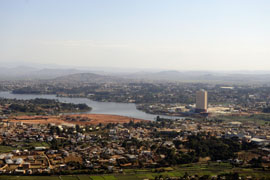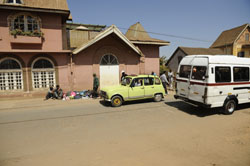Madagascar Hotel GuideNorth Central Madagascar South Best Beach Destinations Rainforest and Mountain Baobabs Other Places |
Madagascar Essential
|
Madagascar Safari Guide
|
Travel Guide to
|
Antananarivo Information Guide
The capital and largest city in Madagascar. It is also known by its French colonial shorthand form Tana. The larger urban area surrounding the city, known as Antananarivo-Renivohitra ("Antananarivo-Mother Hill" or "Antananarivo-Capital"), is the capital of the Analamanga region and of the Antananarivo autonomous province. Unlike most capital cities in southern Africa, Antananarivo was
already a major city before the colonial era. The city was founded
circa 1625 by King Andrianjaka and takes its name (the City of the
Thousand) from the number of soldiers assigned to guard it. For
many years it was the principal village of the Hova chiefs and gained
importance as those chiefs made themselves sovereigns of the greater
part of Madagascar, eventually becoming a town of some 80,000 inhabitants. |
 |
Location |
 |
| Antananarivo Area telephone code +22 Madagascar Phone
code +261 |
|
The city was captured by the French in 1895 and incorporated into their
Madagascar protectorate. After the French conquest of Madagascar when
the city had a population of some 100,000, it was extensively remodelled
as the population grew to 175,000 by 1950. Roads were constructed throughout
the city, broad flights of steps connecting places too steep for the formation
of carriage roads, and the central space, called Andohalo, was enhanced
with walks, terraces, flower-beds and trees. Water, previously obtained
from springs at the foot of the hill, was brought from the Ikopa River,
which skirts the capital to the south and west.
After independence in 1960 the pace of growth increased rapidly. The city's
population reached 1.4 million by the end of the 20th century. Industries
include food products, cigarettes, and textiles.
The city is guarded by two forts built on hills to the east. Including
an Anglican and a Roman Catholic cathedral (this is the see city of the
Roman Catholic Archdiocese of Antananarivo), there are more than 5,000
churches in the city and its suburbs, built in 2008. Antananarivo hosts
a campus of the University of Madagascar and the Collège Rural
d'Ambatobe. Ivato Airport serves the city with several regional routes
and flights to and from Paris, Johannesburg and Nairobi among other cities.
Michele Ratsivalaka succeeded Andry Rajoelina as mayor, who replaced Marc
Ravalomanana as president during the 2009 Malagasy political crisis.
Climate
Antananarivo has a temperate climate. Under the Köppen climate classification,
the city features a borderline subtropical highland climate (Cwb / Cwa).
Owing to its high elevation of 1,300 to 1,400 metres (4,265 to 4,593 ft)
above sea level, the city is known for its mild climate. Antananarivo
receives practically all of its average annual 1,370 millimetres (54 in)
between November and April. The dry season is usually warm and sunny,
although it is sometimes chilly, especially during the nights, and in
the mornings and evenings. Although frosts are rare in Antananarivo, they
are more common at higher elevations. Means range from 22.2 °C (72.0
°F) to 15.3 °C (59.5 °F).
Central Madagascar includes the country's capital and largest city, Antananarivo, as well as a number of other places of interest for visitors, including Antsirabe, Andasibe and Fianarantsoa. This region offers cultural cities, bustling markets, great Antananarivo hotels, stunning lakes and diverse national parks as some of its main attractions. Central Madagascar offers some of the country's biggest cities and best attractions!
Antananarivo or Tananarivo Madagascar ’s capital
Capital of king Andrianampoinimerina (1785 - 1810) built at the site of
Analamanga fortified village which he had just conquered, the city had
been equipped towards 1780 with a garrison with thousand men and had been
renamed “the city of the thousand”, literal meaning of the
current name: Antananarivo. Today, it is familiarly called “Tana”.
Antananarivo or Tananarive
Dominated by the remnant of the imposing “Queen’s Palace”
which was entirely built out of wooden by French Jean Laborde and surrounded
by stone walls by the English missionary James Cameron, known in Malagasy
under the name of “Manjakamiadana” (where one reigns in peace)
and destroyed in 1995 by a case of arson but in the process of rehabilitation
with the assistance of the international community. The city, terminus
of the principal air line was until a recent date the single door of entry
for visitors coming to Madagascar by plane, and represented only as one
crossing point, so that one did not know much about it.
For strategic reasons, its first king had located the heart of the city
at the top of a steep hill and the occupation other hills was only achieved
during the nineteenth century, followed by the expansion on the surrounding
fertile agricultural plain , an expansion which continues at the present
time without true town-planning. The topography of the site explains why
the old city is made out of narrow streets for pedestrian use tangled
up on the heights and hillside, where one can easily get lost while the
recent districts, built in the plain, tend to have a squared plan, especially
in what is called the “cities”.
Residence of the government and economic center, Antananarivo is modernized
to offer all the amenities and the facilities required as well by businessmen
in visit as by the investors. Thanks to its many different level educational
establishments, and to the dynamism of a young population avid of education,
it also offers an important potential of human resources. Those should
still increase for the near future years as the population under 15 years
old does not cease increasing. The city has certainly lost for a few years
some of its picturesque, in particular following the devolution of its
Friday market with the white parasols, the “Zoma” that foreigners
had baptised “the open largest market of the world”, but it
still preserves, in particular in the Upper town, of the historical vestiges
worthy of interest. Visitors who love sport can besides do the visit on
foot by climbing one of its thousand staircases and alleys curving with
cliff side, and enjoy at the same time the imposing panoramic view of
the rice fields being spread out as far as the bluish hills of the four
horizons.
If they wish, they can also benefit from the recent or renewed inherited
installations from the Inter Island game of the Indian Ocean, in particular
an Olympic swimming pool which, unfortunately, does not allow the lifting
dives yet. But at a few minutes of this place, there is another smaller
in size and equipped with a beautiful diving board. If not, walk is particularly
healthy even with more than 1200 meters of altitude, with the proviso
of not beginning in one of the two tunnels of the city, with the manifestly
polluted air. If you however come between October and Mars, go neither
too quickly nor for a long time because the heat is likely to dehydrate
you more than necessary except if you have the chance to get soaked by
one of our tropical downpours.
The appetite sharpened by these physical activities, tourists can taste
the simple but abundant dishes offered by small popular restaurants or
more required establishments offering a vast range of kitchens of all
the countries, but leaning especially towards the Asian taste of Vietnam,
China, Japan and Korea, or go as far as to test the native, nutritive
but very simple dishes, and of a really moderate price.
Lastly, a broad range of lodging is offered there, from the luxurious
hotels to the simplest but convivial guest house at reasonable price.
Here follow among so much of others are attractions which one can see
in the town of Antananarivo:
Visit of the zoological and botanical gardens of Tsimbazaza: this park
shelters representatives of fauna and endemic flora of Madagascar as well
as a museum of paleontology and ethnology. Visit royal palace of Ambohimanga:
located about 20mn from Tana on one of the large sacred hills of Antananarivo.
One finds there the summer palace of queens of Madagascar with its old
pieces of furniture, Andrianampoinimerina’ s royal case dated back
towards 1787, showing the history, the dwelling and the way of life of
an imminent King of his time. Visit of a Lemur Park, a crocodile farm,
a butterfly farm . Visit of a Malagasy silk workshop the “lamba
landy” . Dawdling in the crafts markets such as “artisanal
market of Andravoahangy”, or “the artisanal market of the
Route Digue”, these markets offer several and various articles of
beauty at reasonable prices which one can bargain.
 Places to stay in
Places to stay in